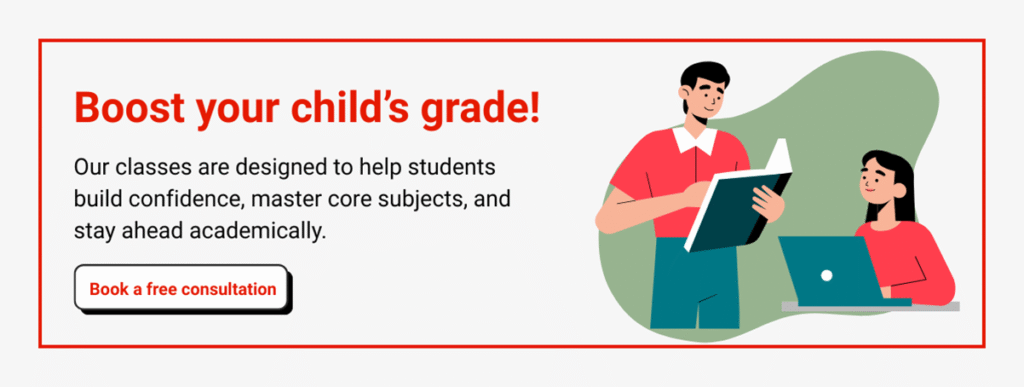As a parent, you want to give your child every chance to succeed, and sometimes, that means a little extra help outside the classroom.
Luckily, there are many options for tutoring support.
The tricky part is choosing between the options available; it can be tricky to know what kind of tutoring is best. Should your child work with a teacher face-to-face, or is online tutoring just as effective (or maybe even better)?
Let’s look at how both formats work, their pros and cons, and how you can decide what’s right for your child.
Why tutoring is a good choice
Every child learns differently. Some kids just need a confidence boost, while others might struggle to keep up with a fast-moving curriculum.
In our experience, we’ve found that tutoring can help in both cases by:
- Providing your child with more attention in smaller groups
- Filling learning gaps (that you either did know existed or didn’t)
- Helping students build better study habits
A good teacher doesn’t just re-teach schoolwork; they help students understand how they learn best.

That might mean developing problem-solving strategies in maths, improving reading comprehension, or simply creating a calmer, one-on-one environment where your child feels comfortable asking questions they might hesitate to raise in class.
Whether in-person or online, the right teacher can make learning enjoyable again and help your child rediscover their confidence.
How in-person tutoring works
In-person tutoring is often considered the traditional approach; your child meets with a teacher face-to-face, whether at home, a tutoring centre, or even in a local library.
This setup can be especially helpful for younger children or students who benefit from hands-on guidance. Equally, sometimes creating a physical barrier between home and tutoring can prove useful.
What are the benefits of in-person tutoring?
- Personal connections: Meeting face-to-face with a teacher can help build trust and rapport quickly.
- Fewer distractions: A structured environment can make it easier to focus.
- Body language and cues: Teachers can pick up on non-verbal signals, like confusion or frustration, and adjust their approach on the spot. Our teachers are very adept at this.
However, in-person sessions can also come with logistical challenges. Travel time, scheduling, and teacher availability in your local area can limit your options.
For busy families or those living in rural areas, that can make consistency difficult.
How online tutoring works
Online tutoring has become increasingly popular, especially after the rise of virtual learning, which became essential during COVID-19.
Sessions take place through video calls, interactive whiteboards, or specialised learning platforms that let students and teachers share screens, solve problems, and work through lessons together.
What are the benefits of online tutoring?
At Excel in Key Subjects, we ensure that young people derive maximum benefit from online learning. Here’s how we do it:
- Flexibility: You can fit lessons around your family’s schedule, no travel required.
- Access to more teachers: You’re not limited by geography, so you can find a teacher who truly matches your child’s needs and personality.
- Technology-enhanced learning: Digital tools like shared documents, quizzes, and recordings can make revision easier and more interactive.
- Recording lessons – for use to revisit the topic or revision: We record many of our online lessons, and provide access to students in a secured area for a period of time.
- We insist that both the teacher and the student have their videos on during the lesson. This is communicated to parents well in advance, and we see this as enhancing safeguarding.
- We insist that most work is in handwriting, rather than typing: We do this in preparation for examinations.
Of course, online tutoring isn’t for every family. For instance, your child might find it harder to focus through a screen, and technical issues (like slow Wi-Fi or device problems) can occasionally interrupt a session.
Younger children, especially, may need extra support from parents to stay engaged online.
Online vs in-person: An overview
Here’s a quick comparison to help you weigh the pros and cons:
| Factor | In-Person Tutoring | Online Tutoring |
| Flexibility | Limited by location and schedule | Highly flexible, learn from anywhere |
| Connection | Strong face-to-face rapport | Virtual connection, still personal with video |
| Engagement | Easier for hands-on learners | Great for tech-savvy or independent learners |
| Resources | Traditional materials (books, worksheets) | Interactive digital tools and recordings |
| Convenience | Requires travel or set meeting spot | No travel time, easy to fit into busy days |
Both formats can be equally effective, it really depends on your child’s learning style, motivation, and your family’s lifestyle.
Deciding what’s right for your child
When choosing between online and in-person tutoring, it’s useful to think about your child’s personality and needs first.
- Younger children often benefit from the structure and hands-on support of in-person lessons.
- Older students, especially those comfortable with technology, may thrive in an online environment where they can take more responsibility for their learning.
- Consider your schedule too. If you’re juggling after-school activities and work commitments, the convenience of online sessions can be a huge help.
It can also be worth trying both. Many tutoring companies (including ours) offer flexible options, allowing families to switch between online and in-person sessions as needed. Sometimes, a blended approach, a mix of both, works best.
At the end of the day, the most important factor isn’t where the tutoring happens, but who your child learns from. A skilled, caring teacher who understands your child’s goals, strengths, and challenges will make all the difference, whether they’re sitting across the table or connecting through a screen.

